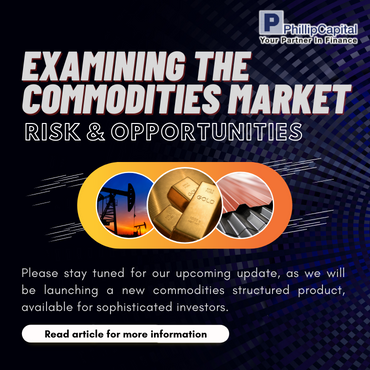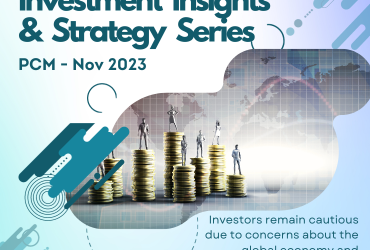
The recent upheaval in the global banking industry has triggered a new black swan to global growth outlook. As a result, the International Monetary Fund (IMF) has lowered its previous projections for worldwide GDP growth, with estimates now at +2.8% for 2023 and +3% for 2024, down from +2.9% and +3.1% respectively. These latest forecasts are more pessimistic compared to the ones released in January 2023. Initial indications in early 2023 that the global economy was headed towards a gentle slowdown, marked by a reduction in inflation and sign of steadier growth, have faded due to persistent high inflation and recent financial sector turmoil. Despite the efforts of central banks to curb inflation by increasing interest rates and the decline in food and energy costs, the underlying inflationary pressures remain stubborn, particularly due to tight labour markets in several economies.
During the initial three and a half months of 2023, the prices of commodities remained uneventful as investors were mostly side-lined while anticipating more clarity on the US Fed’s monetary actions. The financial markets then witnessed a surge in volatility following an unexpected round of liquidity crisis in the global banking sector. Renewed market instability triggered by the possibility of a worldwide economic slowdown caused by a credit crisis has affected the commodities sector in very different ways.
Despite this, at the time of writing, the gold market continues to hold its ground above $2,000 an ounce, registering +10.57% year-to-date. In our earlier article, we expressed our positive outlook towards gold, noting an increase in buying demand from central banks worldwide since last year and a rise in safe haven demand, both of which have been beneficial for the gold market. As investors have become more cautious in response to the sudden appearance of a credit crisis in the global banking sector, the upward momentum of gold prices has then been further reinforced. Looking ahead, the significant decline in long-term yields is a crucial factor that is likely to support the upward trend of gold prices. Additionally, the current market volatility and uncertainty are expected to fuel the demand for gold as a safe haven asset even further.
We were initially expecting elevated energy prices as a result of the on-going supply disruptions stemming from the Russia-Ukraine conflict. However, crude oil prices have fallen back in March to pre-conflict levels of a year ago amidst a sudden global banking crisis, before advancing in April as OPEC and its allies, including Russia, agreed to widen crude oil production cuts. At the time of writing, WTI Crude and Brent Crude advanced 3.74% and 3.03% respectively year-to-date. Looking forward, investors will need to balance the potential impact of a global economic slowdown against ongoing supply risks when considering energy prices. As we noted in our previous article, there is still a risk of a global recession, which has been compounded by the recent banking sector crisis. This has been reflected in the increasing global energy inventories.
Commodities are subject to large price swings in both directions. Even with their volatility, holding them as part of a diversified portfolio can be beneficial. For instance, while equities provide capital growth, bonds offer the much-needed stability and commodities provide a hedge against inflation. While there may be still be volatilities in the commodities market, investing in commodities can provide a unique opportunity for investors to diversify their portfolios and potentially benefit from the unique characteristics of this asset class. Furthermore, commodities are often viewed as an inflation hedge because their prices tend to rise in response to inflation. Investors can get exposure to commodities through exchange-traded funds (ETFs), futures contracts, or shares of commodities-related companies. Separately, it is also possible to invest in a unit trust fund or a wholesale fund that includes a diverse range of commodities.
Please stay tuned for our upcoming update, as we will be launching a new commodities structured product, available for sophisticated investors.
Please click on the link to learn more or email us at cse.my@phillipcapital.com.my if you require any further information.
Disclaimer:
The information contained herein does not constitute an offer, invitation or solicitation to invest in Phillip Capital Management Sdn Bhd (“PCM”). This article has been reviewed and endorsed by the Executive Director (ED) of PCM. This article has not been reviewed by The Securities Commission Malaysia (SC). No part of this document may be circulated or reproduced without prior permission of PCM. This is not a collective investment scheme / unit trust fund. Any investment product or service offered by PCM is not obligations of, deposits in or guaranteed by PCM. Past performance is not necessarily indicative of future returns. Investments are subject to investment risks, including the possible loss of the principal amount invested. Investors should note that the value of the investment may rise as well as decline. If investors are in any doubt about any feature or nature of the investment, they should consult PCM to obtain further information including on the fees and charges involved before investing or seek other professional advice for their specific investment needs or financial situations. Whilst we have taken all reasonable care to ensure that the information contained in this publication is accurate, it does not guarantee the accuracy or completeness of this publication. Any information, opinion and views contained herein are subject to change without notice. We have not given any consideration to and have not made any investigation on your investment objectives, financial situation or your particular needs. Accordingly, no warranty whatsoever is given and no liability whatsoever is accepted for any loss arising whether directly or indirectly as a result of any persons acting on such information and advice.







